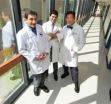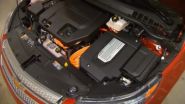(Press-News.org) BALTIMORE—In the event of a flu pandemic, who should have priority access to life-saving ventilators, and who should make that determination? Few disaster preparedness plans have taken community values regarding allocation into account, but a new study is aiming to change that through public engagement with Maryland residents.
"In the event of a healthcare crisis, understanding the community perspective and having citizen buy-in will be critical to avoid compounding the initial disaster with further social upheaval," says principal investigator Elizabeth L. Daugherty Biddison, MD, MPH, Vice Chair for Clinical Operations in the Department of Medicine, Johns Hopkins School of Medicine.
"When life-saving medical resources become scarce, there are no ideal options, even among ethically-permissible ones. Understanding community perspectives and values will help policy-makers craft guidelines for those difficult choices," Biddison says.
To gain this perspective, Biddison and colleagues from the Johns Hopkins Berman Institute of Bioethics, Carnegie Mellon University and University of Pittsburgh Medical Center are exploring the use of "deliberative democratic methods" typically employed to understand how the public views potential policy changes. A pilot study consisted of two community meetings; one in affluent Howard County, which ranks top among the state's county health rankings, and the other in a neighborhood near Johns Hopkins Hospital in inner Baltimore City, which ranks last. The results were published online ahead of print in April in the Annals of the American Thoracic Society.
"We found that participants' ethical perspectives were framed in large part by their place-based life experiences," says Ruth R. Faden, PhD, MPH, director of the Johns Hopkins Berman Institute of Bioethics, a member of the study team. "Our results thus far underscore the importance of broad and diverse community input, to capture more fully the issues that matter to people of various backgrounds."
The community meetings followed the same procedures used to gather information on views related to controversial policy issues including marriage equality, regional tax sharing, and economic redevelopment. According to the study results, the Baltimore City group spent significant time discussing whether particular groups should be disqualified from access to ventilators, such as convicted felons and undocumented immigrants. The study authors connect these concerns directly to crime-rate and demographic trends in the area.
Members of the Howard County community group were recruited by a private-public partnership focused on strengthening local resilience to disasters, and focused on logistical concerns. According to the study, "County residents struggled with the implementation timeframe required by different approaches: would someone die without a ventilator while decision-makers were still making up their minds? County residents also expressed greater concern about the potential for bias in decision making."
Regarding the differences in focus between the two groups, the study states, "[T]he differences reflected distinct ways of thinking about the issues. This finding underscores the importance of achieving a diverse, regionally varied sample of Marylanders" for the project's planned expansion across the state. With such diverse feedback from citizens, "health authorities and elected officials will be better prepared both to shape and to communicate the content of Maryland's future framework in meaningful ways," the study concludes.
Biddison says that the state-wide expansion of the study will include at least 10 forums, five for general community members and five for healthcare professionals. The results will be shared with Maryland health officials for practical application to the state's policy on healthcare resource allocation in the event of a disaster.
INFORMATION:
Links and more information:
Study: "The Community Speaks: Understanding Ethical Values in Allocation of Scarce Lifesaving Resources during Disasters," Annals of the American Thoracic Society (Abstract only without subscription):
http://www.atsjournals.org/doi/abs/10.1513/AnnalsATS.201310-379OC#.U2jwDa1dWDl
Project website: http://www.bioethicsinstitute.org/disaster
Elizabeth L. Daugherty Biddison, MD, MPH: http://www.hopkinsmedicine.org/profiles/results/directory/profile/0019498/elizabeth-daugherty
Ruth R. Faden, PhD, MPH: http://www.bioethicsinstitute.org/people/ruth-faden-4
About the Johns Hopkins Berman Institute of Bioethics:
One of the largest bioethics centers in the world, the Johns Hopkins Berman Institute of Bioethics is the home for collaborative scholarship and teaching on the ethics of clinical practice, public health and biomedical science at Johns Hopkins University. Since 1995, the Institute has worked with governmental agencies, nongovernmental and private sector organizations to address and resolve ethical issues. Institute faculty members represent diverse disciplines including medicine, nursing, law, philosophy, public health and the social sciences. More information is available at http://www.bioethicsinstitute.org.
Who should be saved? Study gets diverse MD community views on healthcare disaster planning
2014-05-14
ELSE PRESS RELEASES FROM THIS DATE:
Strongly interacting electrons in wacky oxide synchronize to work like the brain
2014-05-14
Current computing is based on binary logic -- zeroes and ones -- also called Boolean computing, but a new type of computing architecture stores information in the frequencies and phases of periodic signals and could work more like the human brain using a fraction of the energy necessary for today's computers, according to a team of engineers.
Vanadium dioxide is called a "wacky oxide" because it transitions from a conducting metal to an insulating semiconductor and vice versa with the addition of a small amount of heat or electrical current. A device created by electrical ...
Research shows hope for normal heart function in children with fatal heart disease
2014-05-14
DETROIT, Mich., - After two decades of arduous research, a National Institutes of Health (NIH)-funded investigator at the Children's Hospital of Michigan (CHM) at the Detroit Medical Center (DMC) and the Wayne State University School of Medicine has published a new study showing that many children with an often fatal type of heart disease can recover "normal size and function" of damaged sections of their hearts.
The finding by Children's Hospital of Michigan's Pediatrician-in-Chief and Wayne State University Chair of Pediatrics Steven E. Lipshultz, M.D., F.A.A.P., F.A.H.A., ...
Study finds free fitness center-based exercise referral program not well utilized
2014-05-14
Eliminating financial barriers to a fitness center as well as providing physician support, a pleasant environment and trained fitness staff did not result in widespread membership activation or consistent attendance among low income, multi-ethnic women with chronic disease risk factors or diagnoses according to a new study from Boston University School of Medicine. The findings, published in Journal of Community Health, is believed to be the first study of its kind to examine patient characteristics associated with utilization of community health center- based exercise ...
Study finds outcome data in clinical trials reported inadequately, inconsistently
2014-05-14
Philadelphia, May 14, 2014 – There is increasing public pressure to report the results of all clinical trials to eliminate publication bias and improve public access. However, investigators using the World Health Organization's International Clinical Trials Registry Platform (ICTRP) to build a database of clinical trials involving chronic pain have encountered several challenges. They describe the perils and pitfalls of using the ICTRP and propose alternative strategies to improve clinical trials reporting. This important and insightful study is published in the August ...
Enzyme helps stem cells improve recovery from limb injuries
2014-05-14
AUGUSTA, Ga. – While it seems like restoring blood flow to an injured leg would be a good thing, it can actually cause additional damage that hinders recovery, researchers say.
Ischemia reperfusion injury affects nearly two million Americans annually with a wide variety of scenarios that temporarily impede blood flow – from traumatic limb injuries, to heart attacks, to donor organs, said Dr. Babak Baban, immunologist at the Medical College of Georgia and College of Dental Medicine at Georgia Regents University.
Restoring blood flow actually heightens inflammation ...
By itself, abundant shale gas unlikely to alter climate projections
2014-05-14
DURHAM, N.C. -- While natural gas can reduce greenhouse emissions when it is substituted for higher-emission energy sources, abundant shale gas is not likely to substantially alter total emissions without policies targeted at greenhouse gas reduction, a pair of Duke researchers find.
If natural gas is abundant and less expensive, it will encourage greater natural gas consumption and less of fuels such as coal, renewables and nuclear power. The net effect on the climate will depend on whether the greenhouse emissions from natural gas -- including carbon dioxide and methane ...
New smart coating could make oil-spill cleanup faster and more efficient
2014-05-14
In the wake of recent off-shore oil spills, and with the growing popularity of "fracking" — in which water is used to release oil and gas from shale — there's a need for easy, quick ways to separate oil and water. Now, scientists have developed coatings that can do just that. Their report on the materials, which also could stop surfaces from getting foggy and dirty, appears in ACS Applied Materials & Interfaces.
J.P.S. Badyal and colleagues point out that oil-spill cleanup crews often use absorbents, like clays, straw and wool to sop up oil, but these materials aren't ...
Advance brings 'hyperbolic metamaterials' closer to reality
2014-05-14
WEST LAFAYETTE, Ind. - Researchers have taken a step toward practical applications for "hyperbolic metamaterials," ultra-thin crystalline films that could bring optical advances including powerful microscopes, quantum computers and high-performance solar cells.
New developments are reminiscent of advances that ushered in silicon chip technology, said Alexandra Boltasseva, a Purdue University associate professor of electrical and computer engineering.
Optical metamaterials harness clouds of electrons called surface plasmons to manipulate and control light. However, some ...
New efforts aim to shore up forensic science -- but will they work?
2014-05-14
Five years ago, a report on the state of forensic science by the National Academy of Sciences decried the lack of sound science in the analysis of evidence in criminal cases across the country. It spurred a flurry of outrage and promises, but no immediate action. Now, renewed efforts are underway, according to an article in Chemical & Engineering News, the weekly news magazine of the American Chemical Society.
C&EN editors Andrea Widener and Carmen Drahl note that the 2009 report served as a critical wake-up call to the public, defense attorneys and policymakers. Even ...
Building a longer-lasting, high-capacity electric car battery from sulfur -- video
2014-05-14
WASHINGTON, May 13, 2014 — A new prototype electric car battery could take you a lot farther and last a lot longer. Jeff Pyun, Ph.D., and his team at the University of Arizona are using modified sulfur, a common industrial waste product, to boost the charge capacity and extend the life of these batteries. Their work could also drastically reduce the price of electric car batteries, some of which currently cost more than $10,000 to replace. In the American Chemical Society's (ACS') newest Breakthrough Science video, Pyun and graduate student Jared Griebel explain the technology ...



